Home | Front Page | Blog | Index | New | Contact | Site Map
![]() Center
Center
![]() Sumner
Sumner
![]() Suburbs
Suburbs
![]() Gardens and Parks
Gardens and Parks
![]() Museums
Museums
![]() Visits and Events
Visits and Events
![]() University of Canterbury
University of Canterbury
![]() CC to Dunedin
CC to Dunedin
![]() Dunedin to Invercargill
Dunedin to Invercargill
![]() Invercargill to Milford
Invercargill to Milford
![]() Milford to Greymouth
Milford to Greymouth
![]() Greymouth to Picton
Greymouth to Picton
![]() Wellington
Wellington
![]() Wellington to Auckland
Wellington to Auckland
![]() Auckland
Auckland
![]() Nissan Serena
Nissan Serena
![]() Living Among Kiwis
Living Among Kiwis

Travel 2010
New Zealand
Tokyo
Japan
Darlington
Brussels
Vienna
Travel 2009
Berlin
German Bike Trip
Paris
Britain
Christchurch
Travel 2008
Australia
Britain
Paris
Basel
Berlin
Travel 2007
Sydney
Paris
Britain
USA
Canada
Australia 2007-08
Travel 2006
Greece
Turkey
Thailand
Malaysia
Indonesia
Singapore
Travel 2005
Berlin
Paris
Moscow
Russia
Athens
The Catlins
After Dunedin, our next destination was south towards the Catlins. New Zealand is underpopulated compared to the rest of the world and the Catlins are underpopulated compared to New Zealand: Our kind of place. Not only would you like to visit but you'd like to live there. The coast of the Catlins is beautiful as are the inland rolling hills. Here we found deserted beaches, sea lions and seals, lighthouses, and one of our favorite places to stay, high up on a hill overlooking the ocean where we spent one of our "do-nothing" mental-health days. We sat on the little terrace, sipped chilled NZ sauvignon blanc, while we watched the sheep crop the grass and the clouds scud across the blue, blue sky.
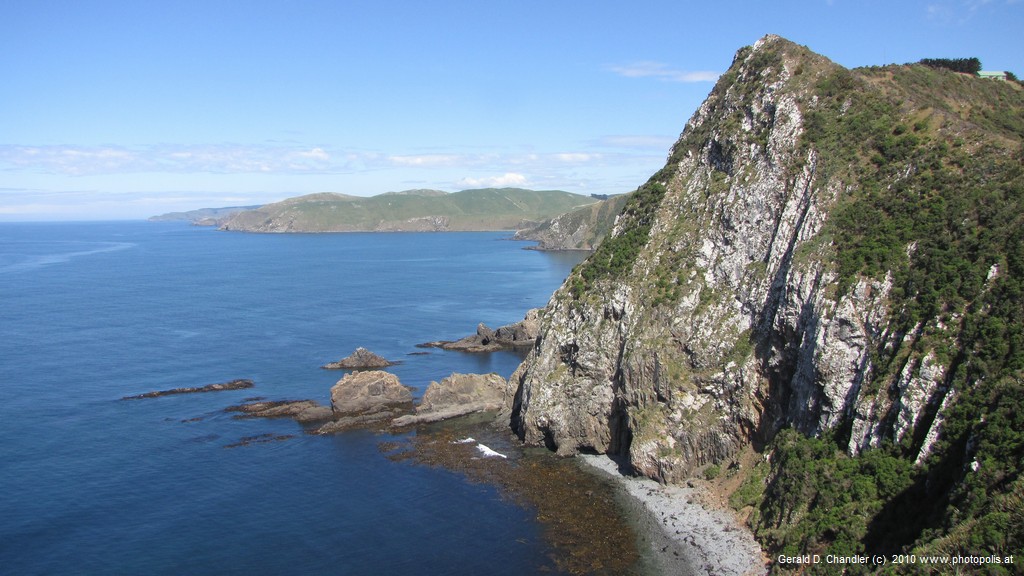
Catlins coast at Nugget Point |

Taieri River Flowers |
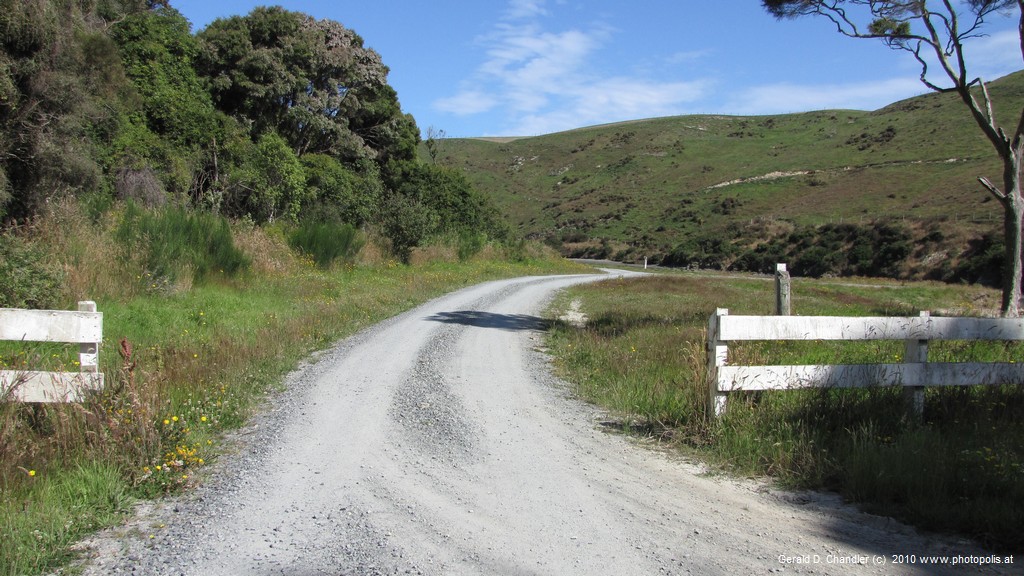
Catlins back country at Akatore |
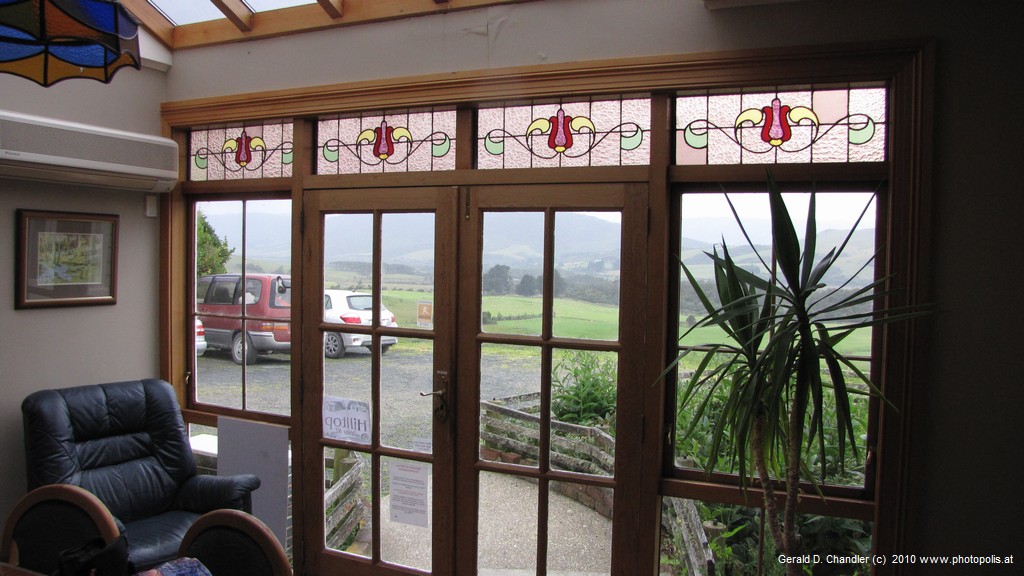
Hilltop Lodge Entry Hall and Fields |
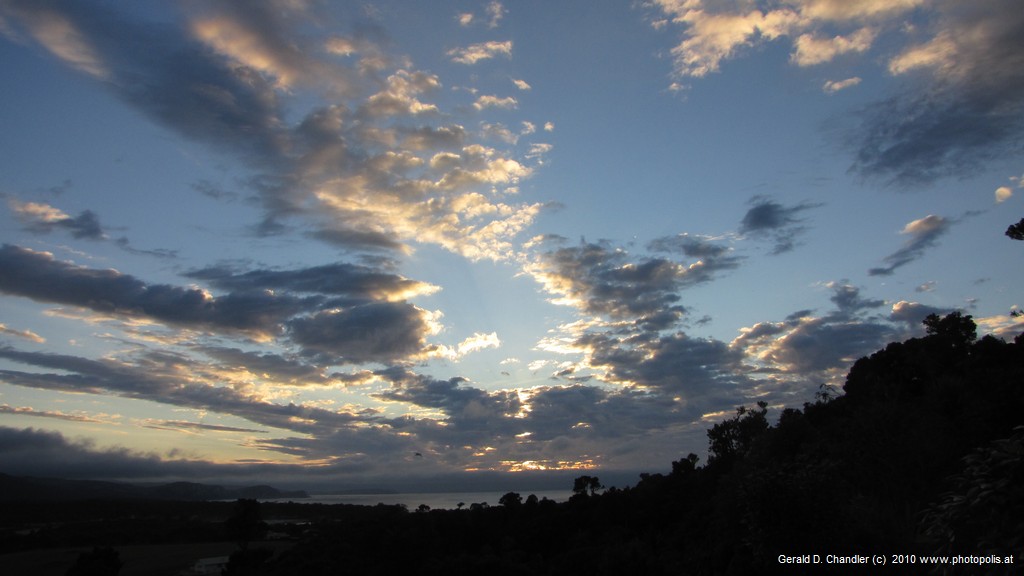
Hilltop Lodge Sky |
Perhaps Jan's favorite memory from the Catlins is of a picnic lunch on a sweep of sandy beach called Cannibal Bay (see below) that was occupied by just one other family. Oops, make that two: a sea-lion family had colonized the far end of the beach. We gave them a very respectful berth on our after lunch stroll. It was a bit of a windy day, producing some lovely whitecaps on the ocean and almost blowing our picnic gear away, but we didn't mind a bit. We were just so happy to have this lovely bit of nature almost all to ourselves. And that, of course, is the secret of New Zealand. There is so much of it that is so pretty, and especially on the South Island, you hardly have to share it with anyone else.
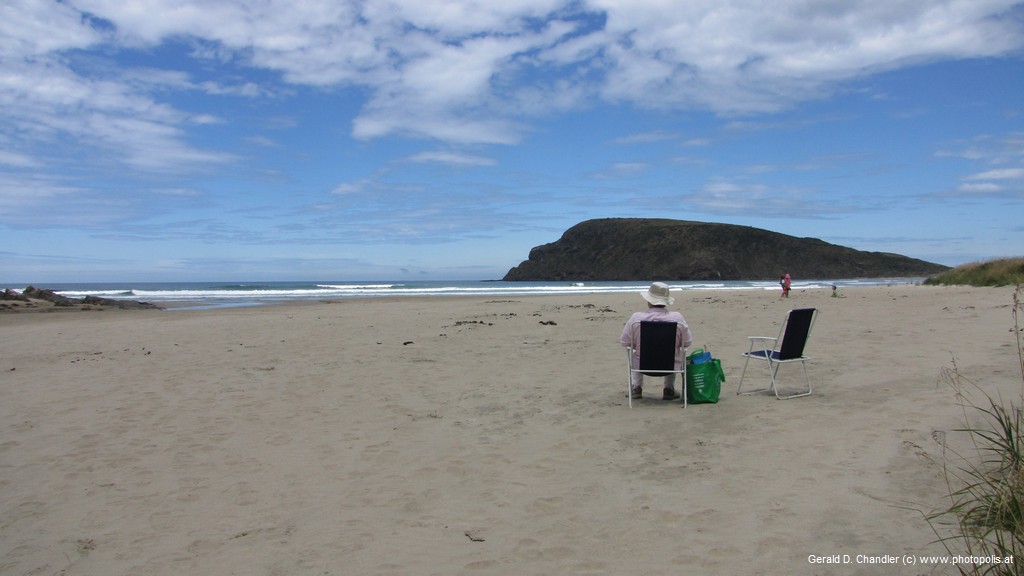
Cannibal Bay Picnic Site |
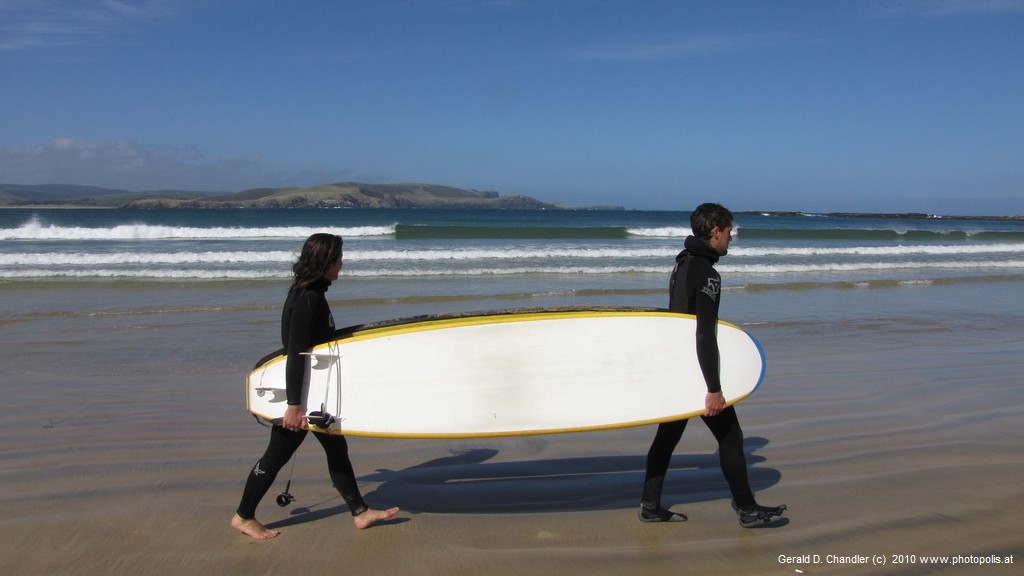
Surfers at Porpoise Bay |

Mother penguin coming ashore at Curio Bay |

Penguin chicks waiting for feeding |
Another very pleasant afternoon was spent near Porpoise and Curio Bays. Our trusty Lonely Planet told us that we might see dolphins here and indeed Jan did get a brief glimpse of dorsal fins way out across the bay. Having seen all that we could see there, we took a walk over to the adjacent bay known for its petrified forest that is exposed at low tide. We were lucky the tide was indeed low, but it was not only petrified trees that were on disply. As we got to the clifftop, we noticed a group of people sitting on rocks, staring at the water. With our binoculars we explored the area they were looking at and spotted a penguin making its way into shore. We had done penguin-spotting up in Oamaru, where we had seen dozens of the tiny foot-high blue penguins risking their lives in the dark dashing from the water across a jetty and then a road and then some open land to get to the cliff face where their nests were. We'd also glimpsed the bigger but rarer yellow-eyed penguins at another nesting site close to Oamaru, but the cliff face there was much higher, the viewpoint was on the top of the cliff, and the nesting penguins much harder to spot than we would have liked. Anyway, by the time we got down the wooden staircase to beach level and to the rock where everyone was gathered, the penguin had made it almost all the way up to the beach and was just 10 meters or so from the cliff face. Yellow-eyed penguins stand about three-four feet tall and unlike the blue penguins, come back to their nests in the late afternoon rather than waiting until after sundown. This bird was clearly visible with the naked eye and so more than lifesize in the binoculars. We were thrilled and expected the show to be over once the penguin reached the cliff. Imagine our delight therefore, to see the penguin re-emerge accompanied by two chicks. Well, chicks isn't quite the word, because although they did have lots of down around their necks, they stood taller than the parent! We got to watch the parent feed them and then try and coax them further away from the nest and down towards the water over the rocky beach. One of them seemed quite willing to follow its parent but the other was much less comfortable and wouldn't venture more than about three or four meters from the cliff. The parent penguin tried several times to go back and encourage the reluctant chick to follow it, but did not succeed and finally gave up and led both chicks back to the nest hidden in the cliff face. We were thrilled to have been spectators at this little play. Definitely one of our most memorable NZ moments.
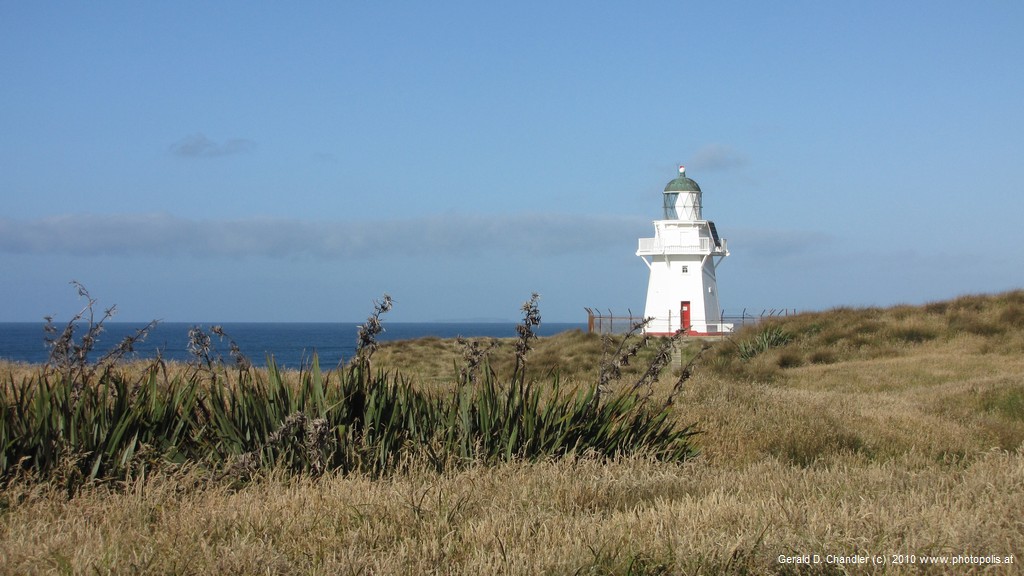
Waipapa Lighthouse |

Waipapa Beach Seals |
Gerry's favorite place in the Catlins was possibly the southernmost tip of the South Island, pictured below. We had to get off the beaten path a bit to get here and didn't know until the last few minutes that we would actually make it because the signage across a farmer's field was so hard to find. But we did make it and of course it reminded us of somewhere else: the southernmost tip of South Africa which we visited and immortalized in 2007.

Slope Point: Southernmost Tip of NZ's South Island |
Invercargill and Bluff
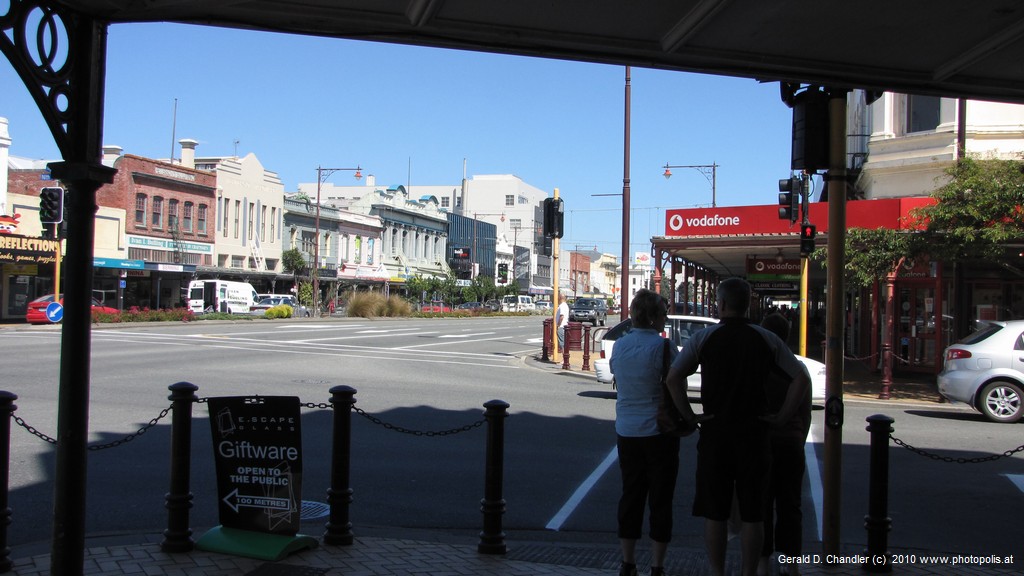
Invercargill Downtown |
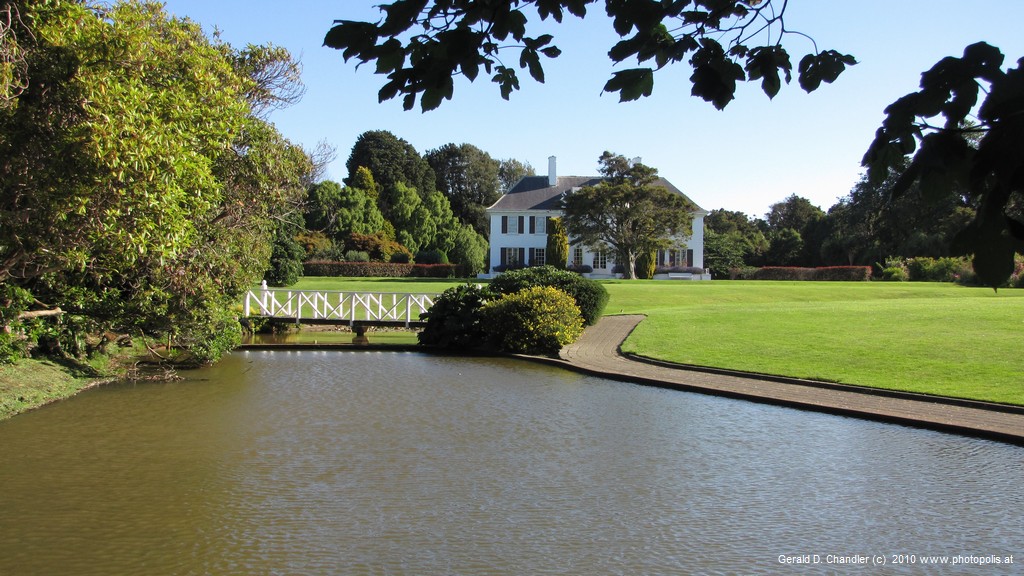
Invercargill Anderson Park |
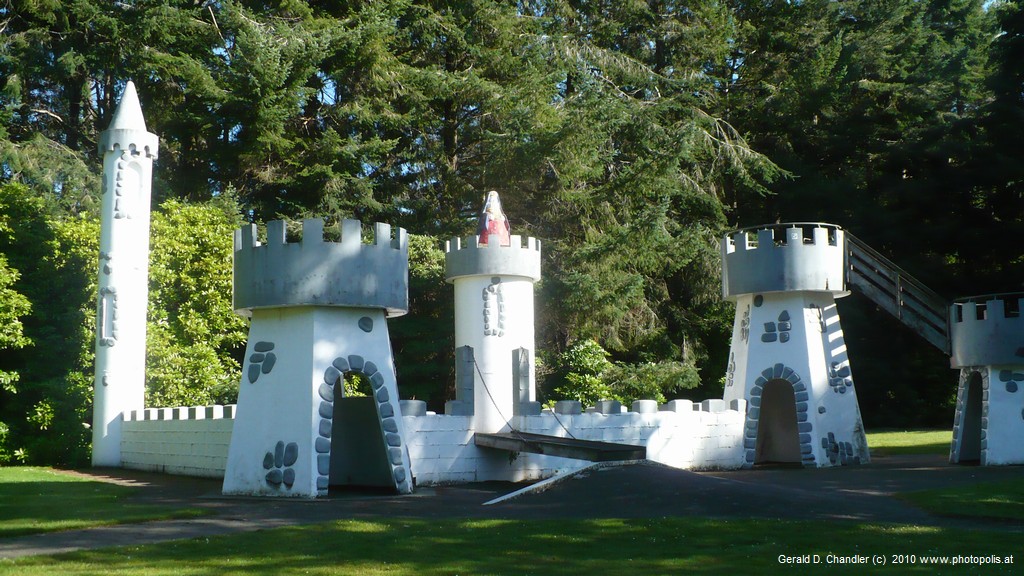
Invercargill Queens Park |
After the Catlins, Invercargill seemed like a big city. Of course, it is only big for New Zealand. Anywhere else it would be a little backwater. But we were happy to get here and settle down for a few days of city-living, in a very comfortable backpacker place called Southern Comfort. We got the bikes out again and took a couple of short rides around town.

Bluff Sterling Point: The Southernmost road-accessible point in NZ
|

Bluff War Memorial |

Bluff Sterling Point Sculpture |
The only real outing we made from Invercargill was to drive out to Bluff, a windy point on the ocean that is famous in New Zealand as the site of the Paua Shell House. While in Christchurch we had seen a museum exhibit on the house. An elderly couple from Bluff were fans of the colorful Paua shell that can be harvested in many of the waters off the coast of New Zealand. They started collecting the shells and used them to decorate their home. The collection grew and so did the decorative uses they found for it. In the end, many of the walls inside their house were covered with Paua shells and they became a local curiosity. They were very friendly folk and if neighbors dropped by they would invite them in. Gradually, they got so many visitors, they found they were taking up more and more of their time. Eventually it became a regular tourist site except that it was still also a real home. In the end the couple died and gifted their collection to the Canterbury museum in Christchurch where we had seen it. We looked for and found the spot where the house was, now sans Paua shells and under new ownership who were refurbishing the place.
It was on the way to Bluff that we first noticed a problem with the newly repaired tyre. It seemed to be slowly leaking. We topped it up and would have had it checked out, except that our tyre repair company, Beaurepaires, didn't have a branch in Invercargill and so we would have to wait until Queenstown. Our only hope was that it would not get too bad before we got there.